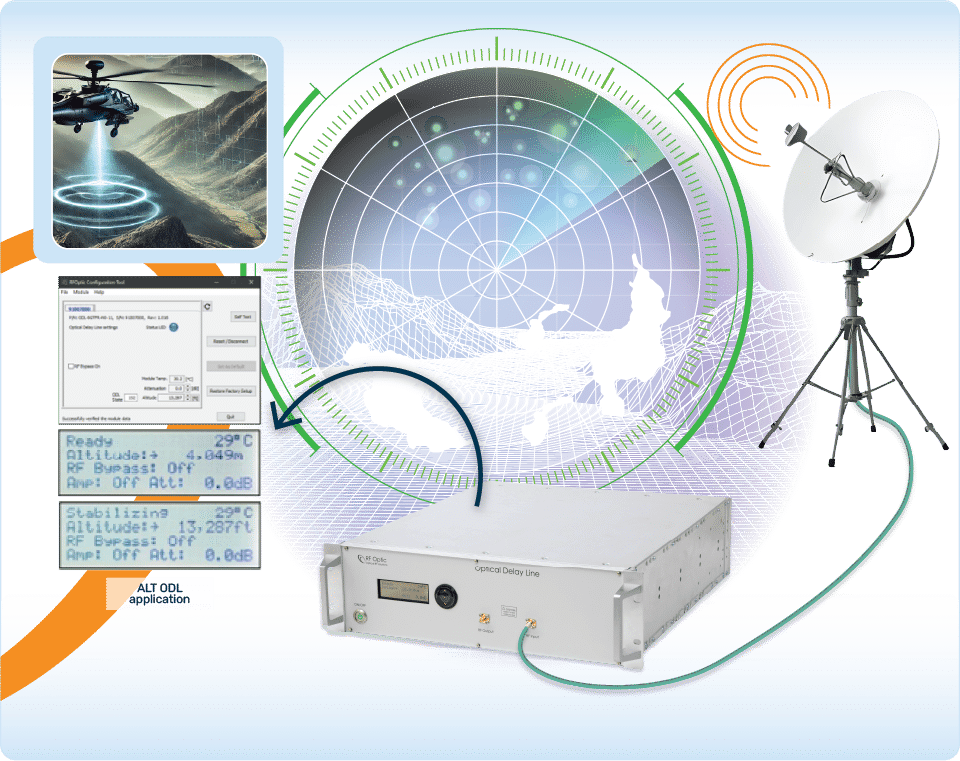
Optical Delay Line Applications
RFOptic’s high-frequency X Optical Delay Line (ODL) series enhances radar testing and RF communication. Utilizing low-loss optical fibers, our ODLs convert RF signals to optical signals, apply precise delays through single-mode fiber, and revert to RF output, ensuring optimal fidelity. With up to 2^24 configurable delay combinations and a range from 1 ns to 500 μs—extendable upon request—these standalone units require no operator intervention.
Key features include easy management via advanced software or an LCD display. Offering ultra-accurate delays and silent operation, our ODLs are perfect for sensitive applications. Options like RF and optical bypass, along with rapid switching under 100 μs, add versatility, while the Mini ODL accommodates short delays up to 32 μs.
Trusted in Electronic Warfare and critical applications, RFOptic’s Optical Delay Lines deliver performance and reliability. Choose RFOptic to enhance your systems with precision delay solutions.
Why use an Optical Delay Line?
Optical Delay Lines (ODLs) are preferred for creating time delays in signal processing due to their ability to maintain high signal integrity over long distances. Compared to traditional electronic methods, ODLs have lower attenuation and distortion, making them ideal for high-frequency applications. They offer flexibility in customizing delay values without the excess noise often introduced by electronic systems, and they operate silently, enhancing reliability. The compact design of optical fibers is beneficial in space-constrained environments, and ODLs are less susceptible to electromagnetic interference, ensuring stable performance. Overall, ODLs provide high fidelity, flexibility, compactness, and resistance to noise, making them an excellent choice for precise timing applications in telecommunications, radar, and scientific research.
Key Features
Optical Delay Lines (ODLs) offer a range of key features that enhance their performance and versatility in various applications. They support a wide delay range, accommodating diverse timing requirements from nanoseconds to microseconds. The high configurability of ODLs, with the capability to manage up to 2^24 distinct delay configurations, allows them to be tailored for specific use cases. Their ultra-low signal loss ensures maximum signal integrity, which is critical for accurate signal processing and measurement. Furthermore, ODLs include options for remote management, providing intuitive interfaces that facilitate easy monitoring and control, allowing for real-time adjustments as needed. Together, these features make Optical Delay Lines an ideal solution for precise timing and signal management applications across multiple industries.
Main Characteristics
- True Time Delay: ODLs provide precise time delays for signals by converting RF signals to optical signals, delaying them through optical fiber, and converting them back.
- Low-Loss Transmission: Utilizing low-loss optical fibers ensures minimal signal degradation and high integrity over long distances, making ODLs suitable for high-frequency applications.
- High Configurability: ODLs can support a vast array of delay combinations (up to 2^24), allowing customization for specific applications.
- Wide Delay Range: They offer a broad range of delay times, typically from 1 ns to 500 μs, with options for longer delays, accommodating diverse processing needs.
- Standalone Operation: Each unit functions independently, which enhances reliability and simplifies integration into various systems without requiring operator intervention.
- Remote and Local Management: ODLs can be easily managed remotely through advanced software or locally via intuitive displays, facilitating efficient monitoring.
- Silent Operation: The operation is ultra-silent, making ODLs ideal for sensitive environments where noise reduction is critical.
- Versatile Options: Features such as RF and optical bypass, as well as rapid switching capabilities (under 100 μs), enhance flexibility for various use cases.
- Compact Design: Many ODLs are designed to be compact, making them suitable for applications where space is limited.
- Proven Reliability: ODLs have demonstrated reliability in critical applications, ensuring consistent performance across various fields including telecommunications, radar technology, and scientific research.
Coverage & Frequencies
Optical Delay Lines (ODLs) are designed to support a comprehensive range of frequency bands, making them versatile for various applications in telecommunications and radar systems. They effectively operate across all frequency bands, including L band, S band, C band, X band, Ku band, K band, Ka band, V band, and beyond. This broad frequency coverage allows ODLs to accommodate diverse signal types and applications, from long-distance communication to high-resolution radar imaging.
System Configuration Example
The Optical Delay Line (ODL) system is engineered to provide precise time delays for RF signals through a combination of advanced components. Central to the system are the RF and fiber transceivers, which convert incoming RF signals into optical signals for processing. This conversion facilitates the integrity of high-frequency signals during transmission.
Key components of the ODL include:
- Delay Spools: These are lengths of low-loss optical fiber wound on spools that introduce the necessary time delay. The length of the spools can be adjusted to achieve varying delay times, accommodating a wide range of application requirements.
- Optical Switches: Integrated optical switches enable dynamic routing of signals through different fiber paths, offering flexibility in configuring delay settings for various operational scenarios.
- Control and Management Unit: This unit oversees the entire ODL system, providing a user interface for configuration and monitoring. It allows for remote operation, real-time adjustments, and status tracking of system performance metrics.
- Optional EDFA: Erbium-Doped Fiber Amplifiers can be included to boost the optical signal strength, particularly useful in long-distance applications where signal attenuation may be a concern.
- Dispersion Compensators: These components are utilized to mitigate signal distortion caused by dispersion in optical fibers, ensuring the fidelity of the transmitted signals over extended lengths.
Main applications
Optical Delay Lines (ODLs) are crucial in various applications, including radar systems for calibration and precise range measurement, telecommunications for signal synchronization across frequency bands from L to V, and electronic warfare for effective signal manipulation. In scientific research, ODLs enable accurate time-of-flight measurements, while in altimeter testing, they simulate altitude changes. Design considerations for ODLs focus on ensuring high frequency stability, low signal loss, silent operation, compactness for space-constrained environments, and features like fast switching and RF bypass options to adapt to dynamic operational conditions. This versatility and adaptability make ODLs essential for achieving precise timing and signal management across multiple fields.
Deployment
- Outdoor Units: RF to optical converters, weatherproof enclosures.
- Indoor Units: Optical to RF converters, redundancy switching units, monitoring equipment.
Installation is typically performed by trained personnel, and RFOptic can provide the necessary cables upon request.
Monitoring & Control
The Optical Delay Line (ODL) system features robust monitoring and control capabilities for efficient operation.
- HTML Interface: A web-based HTML interface provides a user-friendly graphical layout for configuration and monitoring. Accessible via any web browser, it allows quick navigation through system settings and performance metrics.
- REST API: The REST API offers programmatic access, enabling developers to send commands and retrieve status data. This integration facilitates automation and interaction with other systems for customized management solutions.
- SNMP (Simple Network Management Protocol): The ODL system supports SNMP for monitoring, allowing network administrators to collect performance data and receive alerts on issues. This compatibility enhances integration with existing network management tools.
These interfaces ensure users can efficiently manage the Optical Delay Line system, maintain performance, and quickly respond to any arising issues, making them essential for high-reliability applications.
Conclusion
Optical Delay Lines (ODLs) are critical in achieving precise timing and high signal integrity across applications like radar calibration and telecommunications. Their wide delay range, high configurability, and ultra-low signal loss, combined with remote management capabilities, make them essential for optimal performance in high-frequency systems. As demand for accuracy and efficiency grows, ODLs will continue to play a vital role in advancing technology.
Request for Quote







